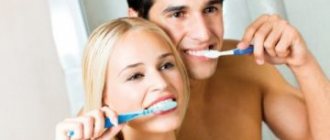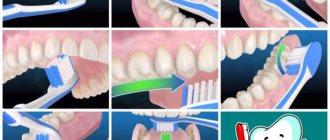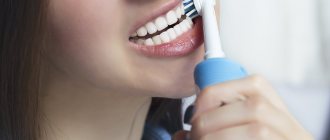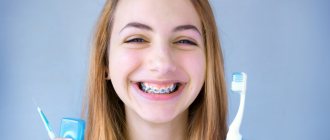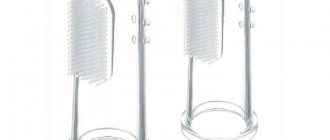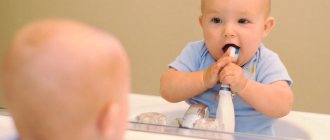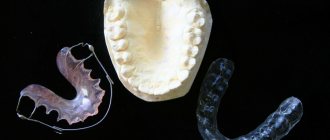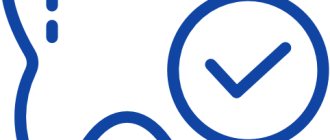To maintain dental health at any age, daily oral hygiene is extremely important. It would seem a simple procedure that does not take much time and does not require any extraordinary skills and efforts. But sometimes even adults are too lazy to do it regularly. What then can we say about kids? They don't even suspect such a need. How to teach a child to brush their teeth every day - morning and evening? What parenting tricks can you use to achieve the best results?
Baby 1 year old
At 1-2 years old, a child cannot yet brush his teeth on his own. But in order to develop a stable habit, this procedure can be carried out by parents until the baby grows up a little.
According to dentists, a child should start brushing his teeth when the very first ones have just erupted. For some it happens earlier, for others later.
But when the baby turns 1 year old, he definitely already has a couple of teeth in his mouth. And they require proper care. While the child does not know how to brush his teeth on his own, one of the parents does it for him using a special silicone brush.
Carry out this procedure regularly after your baby wakes up in the morning and before bed. This will be the initial stage of teaching a child to mandatory and regular brushing of teeth. And when your baby gets a little older, you can safely start teaching him to brush his teeth on his own.
About the loss of baby teeth
- Three cats, three tails.
The series is called “Milk tooth”. In this episode, Caramel's tooth begins to loosen, and the cat is afraid that she will be left without teeth. And my mother explains that this is normal, the tooth is temporary and a new tooth will grow in its place. And if the tooth does not fall out on its own (sometimes this happens), then the pediatric dentist will help, and then the tooth fairy will bring a gift for it! And what gift Caramel received from the tooth fairy you will find out by watching the episode to the end! - Peppa Pig.
The episode is called “The Tooth Fairy” - Luntik.
The series is called “Tooth” - the plot is similar.
December 4, 2021
Child 4-5 years old
By the age of 4-5, many toddlers have already developed a stable habit of brushing their teeth. And parents can begin to draw their attention to the quality of the procedure.
Be patient. You are unlikely to be able to immediately teach your child to take care of his teeth. And that's okay. Moreover, for several more years (approximately until the toddler reaches school age) you will have to control the process itself. Since the baby still cannot properly brush his teeth on his own.
How dangerous is caries for a baby?
Caries is dangerous because the child’s affected teeth become a source of infection, which spreads down the body and can cause very dangerous diseases. In addition, advanced caries is always painful; it is difficult to chew food with a diseased tooth. Of course, the dentist will help the baby, but, firstly, in this case the acquaintance is unlikely to be pleasant, and secondly, in some cases the baby tooth will have to be removed, and premature removal disrupts the formation of the bite, provokes curvature of the permanent ones, and contributes to speech defects .
To avoid such troubles in your baby’s life, you need to start brushing your teeth as early as possible. Of course, a small child will not do this on his own; parents must do this. Many people don't know how to do this or are afraid. A video that shows the process in detail can come to the rescue. You can also visit a dentist who will explain how to brush your baby's teeth using visual aids or various instructional videos.
Recommendations for parents
- Brushing your teeth should not be a routine task for your child. Let it be in a playful way. So that the baby wants to repeat the procedure again and again.
- At the initial stage of your child’s education, your priority is to develop a habit, and not to teach the correct manual skills (how to hold a brush and how to move it, how long to brush your teeth, etc.). First, the baby must understand the importance of what he is doing, become interested, be inspired, and only then begin to follow the process itself.
- Therefore, after your little one brushes her teeth, be sure to check the result and clean them. Explain that not all evil caries were driven away by the child. Next time, let him try to reach with a brush all the nooks and crannies where they might be hiding.
Your child’s healthy, white-toothed smile in the future depends entirely on your patience, your perseverance and responsibility in the present.
Forming your child’s skills and established habit of brushing their teeth depends entirely on you. Be patient and moderately persistent. Your reward will be your child’s beautiful and happy smile for many, many years. And the knowledge that it was you who helped preserve this white-toothed smile.
Specific features of milk units
The structure of milk units is not very different from primary ones, so they also require regular hygiene. Parents often ask the question: at what age should a child brush his teeth? Pediatric dentists recommend practicing hygiene from the moment the first tooth appears. The sooner you teach your baby hygiene, the lower the risk of developing serious diseases. Milk units are also susceptible to the development of pathologies, so they need to be properly and competently cared for. It is very important that parents prevent the development of caries on baby teeth, otherwise they will have to undergo treatment in the dental office.
Video “When should you start teaching your baby to brush his teeth?” Komarovsky
- Author: Polina
Hello. My name is Polina. Having once heard the truth that a pediatrician is the main doctor for any family with small children, I realized that I had something to strive for. Rate this article:
- 5
- 4
- 3
- 2
- 1
(1 vote, average: 3 out of 5)
Share with your friends!
Oral hygiene or rules for choosing toothpaste and brushes for a baby.
Where to celebrate New Year with a child (if the baby is only 1-2 years old)
Brushes and pastes for children
After six months, the baby’s ejection reflex disappears, and you can replace napkins and tampons with silicone brushes that fit on your finger, or regular toothbrushes with soft bristles and a cleaning surface of no more than two children’s teeth . With them, parents can carefully, gently and carefully clean the child’s oral cavity without causing him pain.
This is also the time to start using toothpaste. For the little ones there is:
- gel-like paste: it has a milky taste or is tasteless, does not contain abrasive substances, is recommended for children who are not yet receiving complementary foods;
- fruit-flavored paste: recommended for children already receiving complementary foods.
Features of professional oral hygiene
There are 4 methods of professional plaque removal. But not all of them are suitable for children. Ultrasound and laser are allowed from 14 years of age. Mechanical cleaning is practically no longer used.
A three-year-old boy has his teeth cleaned at the dentist:
In childhood, soft stone removal is carried out using the Air-flow method, but only when the enamel is mineralized. It is finally formed a year after eruption. The sandblasting technique perfectly eliminates hard and soft plaque and prevents caries.
When should you teach your child to practice self-hygiene?
It is advisable to teach your child to brush their teeth on their own from the age of 3.
At the age of 5-7 years, a change in bite begins, and baby teeth gradually replace the first permanent ones.
According to dentists, it is in preschool age that a child should know the basic rules of brushing teeth and be able to apply them in practice.
Namely:
- rinse your toothbrush with warm water at room temperature;
- squeeze toothpaste out of the tube correctly and in the right amount;
- be confident in the “standard method” of brushing teeth, consisting of vertical, horizontal and circular movements;
- At the end of the procedure, rinse your mouth thoroughly with warm water.
Cleaning technology with installed braces
Restoring correct occlusion with braces is an important stage of dental treatment.
But this may cause a side effect in the form of hard deposits or caries. This is due to the fact that it is quite difficult to reach the surface located behind the braces.
To avoid this, it is necessary to approach the cleaning procedure with special care, which is carried out in several steps:
- Place any type of brush at an acute angle (45°) relative to the front surface of the tooth.
- Using gentle pressure, begin to clean the crown, alternating back and forth. This action removes plaque from both the internal and external surfaces.
- After this, start cleaning the bracket. To do this, brush the brush several times, first from the gum line to the cutting part, then vice versa. When doing this, avoid pressing too hard to avoid damaging the structure.
- Then, carry out the procedure for cleaning the crown of the chewing part, placing the brush perpendicularly. The movements should be circular, with slight pressure. But do not overdo it, as you can injure your gums.
- Repeat a similar process on each tooth. The time for one section is 10 seconds.
To care for teeth with installed braces, it is recommended to use a special brush and additional devices (brush, floss, irrigator).
A brush for such purposes should have a structured shape, where the bristles are shortened towards the middle along the entire length of the head. Ideally, this shape should resemble the letter “V”.
Next is a training video on how to care for braces:
Technology using different types of brushes
Improper cleansing is one of the main causes of diseases of dental and periodontal tissue. Even though most people know the general rules for cleaning their mouth, it is not always effective.
First of all, it depends on the type of brush used, since each device requires its own technology.
Regular
This process, using a standard brush, should last at least three minutes . The number of procedures cannot be less than twice a day. The best option is to use the brush after eating.
The process itself consists of several steps:
- wet the brush with water and apply the required amount of paste;
- start the procedure from the upper jaw, visually dividing it into two segments;
- the process should begin with the front incisors, gradually moving towards the molars;
- position the brush in relation to the front surface at an angle of 45°, at the base of the crown;
- Using a sweeping motion, from the gum pocket to the cutting part, we clean the front sides of the tooth;
- when working on the inside, the brush must be directed at a slight angle vertically;
- The cutting surface is cleaned using circular movements. In this case, the brush is positioned perpendicular to the chewing side;
- We process the bottom row in the same way.
- Finally, clean your tongue and rinse your mouth with water or mouthwash.
Next is a training video with visual examples of using a regular toothbrush:
Electrical
An electric brush is an effective means of removing deposits from enamel. It allows cleaning without any effort, since when turned on it makes circular movements at maximum speed.
But when using it, you must remember that such a device can cause harm in case of periodontal diseases, leading to high tooth mobility. Use after surgery in the oral cavity is also contraindicated.
Step-by-step description of the procedure for cleansing the oral cavity with an electric brush:
- moisten the brush under running water and apply the required amount of paste. Do not squeeze out a large amount of paste, as the high speed of the device may cause the formation of excessive foam. This will complicate the cleaning procedure and increase its time;
- Place the device horizontally so that the bristles of the head cover the chewing surface of the crown and turn on the device. Start the procedure from the front incisors, gradually moving towards the back teeth;
- hold the brush in this position for 3 or 4 seconds. Light reciprocating movements of the device along the crown are allowed;
- move the device to a vertical position and process the inside and outside;
- After completely cleaning one tooth, move the brush to another with a smooth movement.
The following video will teach you how to use an electric toothbrush correctly:
Ultrasonic
An ultrasonic brush is a tool that cleans crowns using high-frequency waves. This device allows you to remove pathogenic particles not only on the visible part, but also in the gum pockets at a depth of up to 4 mm .
Detailed usage description:
- Before use, set the required mode. As a rule, brushes of this type have several modes: standard, with or without vibration, and enhanced.
- A small amount of paste is applied to moistened bristles. Typically no larger than the size of a pea is recommended;
- start the process from the farthest molar;
- position the head of the device at an acute angle to the inside of the crown;
- turn on the device and, using circular movements, first clean the gum pocket, and then the entire surface of the crown, gradually moving towards the chewing part;
- The same method is used to remove plaque from the outer part;
- The chewing side is treated with a brush located horizontally. In this case, it is necessary to make movements back and forth on the surface;
- Excessive physical effort should be avoided during the cleansing process. It should take at least 1.5 minutes to treat the dentition of one jaw.
The following video contains recommendations for the correct use of a sonic toothbrush (watch from the 4th minute):
Monobeam
The monobeam brush appeared not so long ago, but has already gained great popularity. With it you can easily clean all hard-to-reach places, including interdental spaces and gum pockets . This made the brush popular among people with orthodontic structures.
The device is very convenient to use, as it is small in size. It can also be used without toothpaste.
To get the proper result, you must carry out the cleansing procedure correctly:
- visually determine the segments of the dentition and the order of cleaning. We start work from any segment convenient for you;
- One of the important nuances when using a mono-beam brush is the correct grip of the handle. Fingers must be placed on power ledges to prevent slipping;
- place the device at an angle (approximately 45°) to the tooth line bordering the gum;
- moving in a semicircle, as if sweeping out a gum pocket;
- after which we clean the internal, external and cutting surfaces in a circular motion;
- During the process, you should not make special efforts so as not to injure the mucous tissue. The procedure for cleaning one tooth lasts about 10 seconds.
Using this device is very simple - watch the video:
We have prepared instructions for Crest Whitestrips teeth whitening strips in a special publication.
We invite you to look at the photo and find out what periodontitis looks like.
Here: https://zubovv.ru/ortodontiya/breketyi/skolko-stoyat-na-zubyi-dlya-korrektsii-prikusa.html - we’ll tell you how much sapphire braces cost.
Cleaning Rules
The outer, inner and chewing surfaces should be cleaned using sweeping movements, from the gums to the edges of the bone tissue. Rotational movements massage the gums.
The technique looks like this:
- clean external surfaces;
- clean internal surfaces;
- clean chewing surfaces;
- clean your tongue.
1 step 2 step 3 step 4 step 5 step 6 step 7 step 8 step
Procedure time – 1 min. There is no need to press hard on the brush. Thus, gums and enamel can be damaged.
How is cleaning done at the dentist?
It is advisable that the pediatrician find an approach to the child, because if the baby is afraid, then the matter will not come to cleaning.
Procedure steps:
- If necessary, to eliminate even the slightest pain, an anesthetic gel is applied to the gums.
- Sanitation of the oral cavity is mandatory.
- Special soft brushes are used.
- The dentist cleans each tooth. First from the front, then from the back (vestibular and oral side).
- Then the surfaces are polished and fluoridated.
After the procedure, a hygiene lesson is required. The dentist will show you how neat your teeth have become and tell you how to properly care for them.
